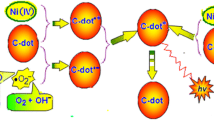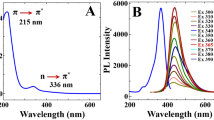Abstract
Carbon dots doped with sulfur and nitrogen (S,N-CDs) were utilised to design a paper-stripe based fluorescent probe for the detection of bilirubin. The S,N-CDs were synthesized through a microwave assisted route by using citric acid as carbon source and L-cysteine as a source of nitrogen and sulfur. The S,N-CDs exhibit bright blue fluorescence emission with a peak at 452 nm. Fluorescence is quenched by Fe(III) but selectively restored by bilirubin. The quenched fluorescent probe exhibit significant selectivity and sensitivity for bilirubin in the 0.2 nM to 2 nM concentration range, with a 0.12 nM detection limit. The method was applied to the determination of bilirubin in spiked human serum and urine samples. The method was used to design a paper based test stripe as a point of care device for visual bilirubin detection.

Schematic representation of sulphur and nitrogen doped carbon dots whose fluorescence is quenched by Fe(III) and turned on by bilirubin. Photograph of the corresponding system under day light and UV shows the feasibility of the phenomenon. The applicability of the assay was further extended by impregnating the probe on a filter paper.





Similar content being viewed by others
References
Tikmani SS, Warraich HJ, Abbasi F, Rizvi A, Darmstadt GL, Zaidi AK (2010) Incidence of neonatal hyperbilirubinemia: a population-based prospective study in Pakistan. Tropical Med Int Health TM & IH 15(5):502–507. https://doi.org/10.1111/j.1365-3156.2010.02496.x
Basu S, Sahoo AK, Paul A, Chattopadhyay A (2016) Thumb imprint based detection of hyperbilirubinemia using luminescent gold nanoclusters. Sci Rep 6:39005. https://doi.org/10.1038/srep39005 https://www.nature.com/articles/srep39005#supplementary-information
Maisels MJ (2015) Managing the jaundiced newborn: a persistent challenge. CMAJ 187(5):335–343. https://doi.org/10.1503/cmaj.122117
Santhosh M, Chinnadayyala SR, Kakoti A, Goswami P (2014) Selective and sensitive detection of free bilirubin in blood serum using human serum albumin stabilized gold nanoclusters as fluorometric and colorimetric probe. Biosens Bioelectron 59:370–376. https://doi.org/10.1016/j.bios.2014.04.003
Zhang JJ, Cheng FF, Li JJ, Zhu J-J, Lu Y (2016) Fluorescent nanoprobes for sensing and imaging of metal ions: recent advances and future perspectives. NanoToday 11:309–329. https://doi.org/10.1016/j.nantod.2016.05.010
Li JJ, Cheng FF, Huang H, Li L, Li J-J (2015) Nanomaterial based activatable imaging probes: from design to biological applications. Chem Soc Rev 44:7855. https://doi.org/10.1039/c4cs00476k
Xu Q, Kuang T, Liu Y, Cai L, Peng X, Sreenivasan Sreeprasad T, Zhao P, Yu Z, Li N (2016) Heteroatom-doped carbon dots: synthesis, characterization, properties, photoluminescence mechanism and biological applications. J Mater Chem B 4(45):7204–7219. https://doi.org/10.1039/C6TB02131J
Lim SY, Shen W, Gao Z (2015) Carbon quantum dots and their applications. Chem Soc Rev 44(1):362–381. https://doi.org/10.1039/C4CS00269E
Miao X, Yan X, Dan Q, Li D, Tao FF, Sun Z (2017) Red emissive sulfur, nitrogen doped carbon dots and their application in ion detection and theranostics. ACS Appl Mater Interfaces 9:18549–18556. https://doi.org/10.1021/acsami.7b04514
Zohu X, Gao X, Liu M, Wang C, Chu F (2017) A poly (5-Indolylboronic acid) based molecular imprint doped with carbon dots for fluorometric determination of glucose. Microchim Acta 184:4175–4181. https://doi.org/10.1007/s00604-017-2448-0
Wang R, Wang X, Sun Y (2017) Aminophenol-based carbon dots with dual wavelength fluorescence emission for determination of heparin. Microchim Acta 184(1):187–193. https://doi.org/10.1007/s00604-016-2009-y
Yang H, Li F, Zou C, Huang Q, Chen D (2017) Sulfur-doped carbon quantum dots and derived 3D carbon nanoflowers are effective visible to near infrared fluorescent probes for hydrogen peroxide. Microchim Acta 184(7):2055–2062. https://doi.org/10.1007/s00604-017-2181-8
Dong Y, Wang R, Tian W, Chi Y, Chen G (2014) “Turn-on” fluorescent detection of cynide based on polyamine functionalized carbon quantum dots. RSC Adv 4:3701. https://doi.org/10.1039/c3ra45893h
Dai H, Shi Y, Wang Y, Sun Y, Hu J, Ni P, Li Z (2014) A carbon dot based biosensor for melamine detection by fluorescenc resonance energy transfer. Sensors Actuators B Chem 202:201–208. https://doi.org/10.1016/j.snb.2014.05.058
Anjali Devi JS, Salini S, Anulekshmi AH, Praveen GL, Sony G (2017) Fe (III) ion modulated l-DOPA protected gold nanocluster probe for fluorescence turn on sensing of ascorbic acid. Sensors Sens Actuators B Chem 246:943–951. https://doi.org/10.1016/j.snb.2017.02.151
Dhenadhayalan N, Lin K-C, Suresh R, Ramamurthy P (2016) Unravelling the multiple emissive states in citric-acid-derived carbon dots. J Phys Chem C 120(2):1252–1261. https://doi.org/10.1021/acs.jpcc.5b08516
Pan L, Sun S, Zhang A, Jiang K, Zhang L, Dong C, Huang Q, Wu A, Lin H (2015) Truly fluorescent excitation-dependent carbon dots and their applications in multicolor cellular imaging and multidimensional sensing. Adv Mater (Deerfield Beach, Fla) 27(47):7782–7787. https://doi.org/10.1002/adma.201503821
Margraf JT, Strauss V, Guldi DM, Clark T (2015) The electronic structure of amorphous carbon nanodots. J Phys Chem B 119(24):7258–7265. https://doi.org/10.1021/jp510620j
Yin J, Ren W, Yang G, Duan J, Huang X, Fang R, Li C, Li T, Yin Y, Hou Y, Kim SW, Wu G (2016) L-cysteine metabolism and its nutritional implications. Mol Nutr Food Res 60(1):134–146. https://doi.org/10.1002/mnfr.201500031
Chen Y, Wu Y, Weng B, Wang B, Li C (2016) Facile synthesis of nitrogen and sulfur co-doped carbon dots and application for Fe(III) ions detection and cell imaging. Sensors Actuators B Chem 223:689–696. https://doi.org/10.1016/j.snb.2015.09.081
Amjadi M, Manzoori JL, Hallaj T, Azizi N (2017) Sulfur and nitrogen co-doped carbon quantum dots as the chemiluminescence probe for detection of Cu2+ ions. J Lumin 182:246–251. https://doi.org/10.1016/j.jlumin.2016.10.021
Schneider J, Reckmeier CJ, Xiong Y, von Seckendorff M, Susha AS, Kasák P, Rogach AL (2017) Molecular fluorescence in citric acid-based carbon dots. J Phys Chem C 121(3):2014–2022. https://doi.org/10.1021/acs.jpcc.6b12519
Liu Y, Zhou L, Li Y, Deng R, Zhang H (2017) Highly fluorescent nitrogen-doped carbon dots with excellent thermal and photo stability applied as invisible ink for loading important information and anti-counterfeiting. Nano 9(2):491–496. https://doi.org/10.1039/C6NR07123F
Zhang Y, He J (2015) Facile synthesis of S, N co-doped carbon dots and investigation of their photoluminescence properties. Phys Chem Chem Phys 17(31):20154–20159. https://doi.org/10.1039/C5CP03498A
Ding H, S-B Y, Wei J-S, Xiong H-M (2016) Full-color light-emitting carbon dots with a surface-state-controlled luminescence mechanism. ACS Nano 10(1):484–491. https://doi.org/10.1021/acsnano.5b05406
Hong G, Diao S, Antaris AL, Dai H (2015) Carbon Nanomaterials for biological imaging and nanomedicinal therapy. Chem Rev 115(19):10816–10906. https://doi.org/10.1021/acs.chemrev.5b00008
Park Y, Yoo J, Lim B, Kwon W, Rhee SW (2016) Improving the functionality of carbon nanodots: doping and surface functionalization. J Mater Chem A 4(30):11582–11603. https://doi.org/10.1039/C6TA04813G
Dutta Choudhury S, Chethodil JM, Gharat PM, Praseetha PK, Pal H (2017) pH-elicited luminescence functionalities of carbon dots: mechanistic insights. J Phys Chem Lett 8(7):1389–1395. https://doi.org/10.1021/acs.jpclett.7b00153
Zu F, Yan F, Bai Z, Xu J, Wang Y, Huang Y, Zhou X (2017) The quenching of the fluorescence of carbon dots: a review on mechanisms and applications. Microchim Acta 184(7):1899–1914. https://doi.org/10.1007/s00604-017-2318-9
Yoosaf K, Ipe BI, Suresh CH, Thomas KG (2007) In situ synthesis of metal nanoparticles and selective naked-eye detection of lead ions from aqueous media. J Phys Chem C 111(34):12839–12847. https://doi.org/10.1021/jp073923q
Li G, Fu H, Chen X, Gong P, Chen G, Xia L, Wang H, You J, Wu Y (2016) Facile and sensitive fluorescence sensing of alkaline phosphatase activity with Photoluminescent carbon dots based on inner filter effect. Anal Chem 88(5):2720–2726. https://doi.org/10.1021/acs.analchem.5b04193
Li S, Li Y, Cao J, Zhu J, Fan L, Li X (2014) Sulfur-doped graphene quantum dots as a novel fluorescent probe for highly selective and sensitive detection of Fe3+. Anal Chem 86(20):10201–10207. https://doi.org/10.1021/ac503183y
Tang T, Ouyang J, Hu L, Guo L, Yang M, Chen X (2016) Synthesis of peptide templated copper nanoclusters for fluorometric determination of Fe(III) in human serum. Microchim Acta 183(10):2831–2836. https://doi.org/10.1007/s00604-016-1935-z
Li G, Lv N, Bi W, Zhang J, Ni J (2016) Nitrogen-doped carbon dots as a fluorescence probe suitable for sensing Fe3+ under acidic conditions. New J Chem 40(12):10213–10218. https://doi.org/10.1039/C6NJ02088G
Hullin DA, McGrane MT (1991) Effect of bilirubin on uricase-peroxidase coupled reactions. Implications for urate measurement in clinical samples and external quality assessment schemes. Ann Clin Biochem 28(Pt 1):98–100. https://doi.org/10.1177/000456329102800117
Rand RN, Ad P (1962) A new Diazo method for the determination of bilirubin. Clin Chem 8(6):570–578
Santhosh M, Chinnadayyala SR, Singh NK, Goswami P (2016) Human serum albumin-stabilized gold nanoclusters act as an electron transfer bridge supporting specific electrocatalysis of bilirubin useful for biosensing applications. Bioelectrochemistry (Amsterdam, Netherlands) 111:7–14. https://doi.org/10.1016/j.bioelechem.2016.04.003
Senthilkumar T, Asha SK (2015) Selective and sensitive sensing of free bilirubin in human serum using water-soluble Polyfluorene as fluorescent probe. Macromolecules 48(11):3449–3461. https://doi.org/10.1021/acs.macromol.5b00043
Jansen T, Daiber A (2012) Direct antioxidant properties of bilirubin and Biliverdin. Is there a role for biliverdin reductase? Front Pharmacol 3:30. https://doi.org/10.3389/fphar.2012.00030
Fevery J (2008) Bilirubin in clinical practice: a review. Liver Int 28(5):592–605. https://doi.org/10.1111/j.1478-3231.2008.01716.x
Wu H, Jiang J, Gu X, Tong C (2017) Nitrogen and sulfur co-doped carbon quantum dots for highly selective and sensitive fluorescent detection of Fe(III) ions and L-cysteine. Microchim Acta 184(7):2291–2298. https://doi.org/10.1007/s00604-017-2201-8
Acknowledgements
The authors acknowledge the Professor and Head of the Department of Chemistry, University of Kerala for providing the research facilities. Authors also appreciate SAIF, MGU – India.
Author information
Authors and Affiliations
Corresponding author
Ethics declarations
The author(s) declare that they have no competing interests.
Electronic supplementary material
ESM 1
(DOCX 2.50 mb)
Rights and permissions
About this article
Cite this article
Anjana, R.R., Anjali Devi, J.S., Jayasree, M. et al. S,N-doped carbon dots as a fluorescent probe for bilirubin. Microchim Acta 185, 11 (2018). https://doi.org/10.1007/s00604-017-2574-8
Received:
Accepted:
Published:
DOI: https://doi.org/10.1007/s00604-017-2574-8




